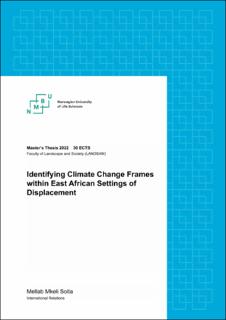| dc.description.abstract | Whether forced or voluntary, mobility related to climate change affects developing and developed countries with the most vulnerable groups affected more. Humanitarian crises are a concern across the globe significantly when they contribute to rising levels of displacement. Climate change in connection with displacement has been framed in multiple ways across regions. Understanding how the climate change phenomenon is interpreted, perceived, and experienced in different settings is crucial to understanding what information various frames intend to highlight and the purpose therein.
In order to grasp the growing concern of humanitarian crises with respect to climate change, I explore how the climate change phenomenon is framed by humanitarian actors with a focus on displacement settings in East Africa. The objective of this thesis research is to identify climate change frames adopted by humanitarian actors within East African settings of displacement since the East African region houses a large number of displaced persons.
This thesis research follows a constructivist approach, which holds that reality is socially constructed and that there are multiple realities or ways of perceiving and interpreting phenomena depending on the social and natural circumstances. A combination of a systematic literature review and semi-structured interviewing procedures was adopted to explore the perspectives around the framing of climate change within the East African settings of displacement.
Findings indicate that climate change in the East Africa region as framed by humanitarian actors is perceived mainly by how it affects the displaced persons, and the organizations providing aid response, while also highlighting the dependence of the displaced persons on the natural environment. The conclusions are that the framing of climate change in this particular context is highly centered around: livelihood protection, need for physical safety, clean energy needs, environmental protection, local governance, donor requirements, and the implications on future humanitarian response. The frames highlight the context-specific circumstances, the perceived/constructed realities surrounding climate change and aid assistance, and the plight of displaced persons in East Africa and connect to the broader sustainable development goals. | en_US |

